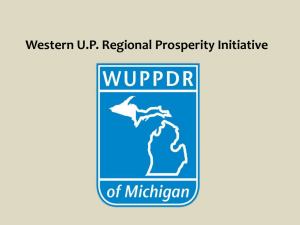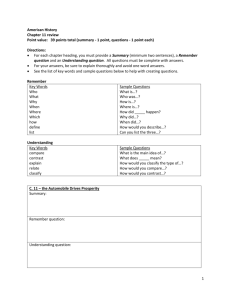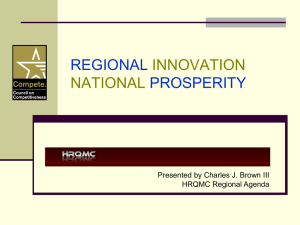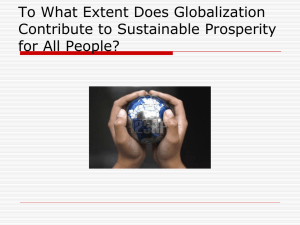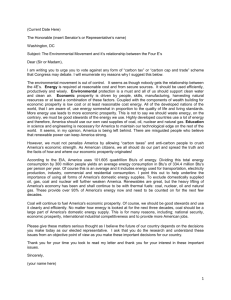Designing and building a 21st century livable society
advertisement
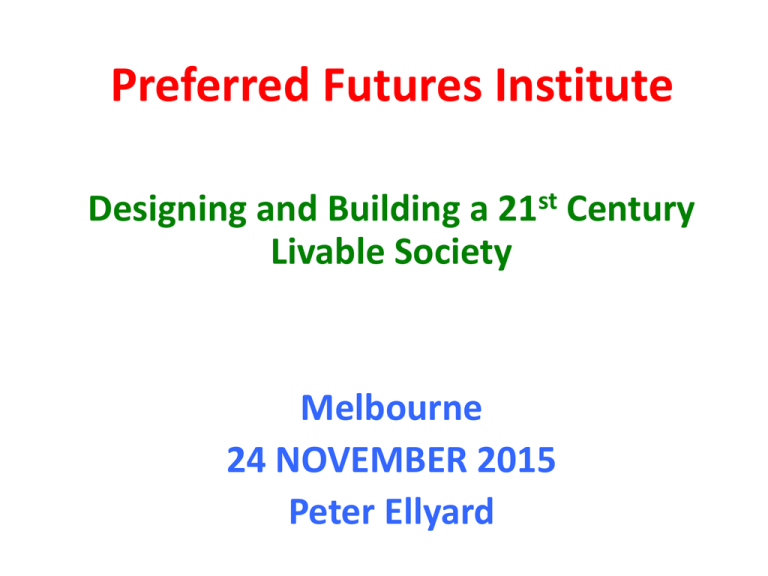
Preferred Futures Institute Designing and Building a 21st Century Livable Society Melbourne 24 NOVEMBER 2015 Peter Ellyard A Livable Society A Livable Society is : Prosperous + Harmonious + Inclusive + Sustainable + Healthy + Secure A Universally Livable Planet 2050? Global markets demanding and supplying the products and services – the ways and wares- to achieve this. Global collaboration and ethics that make such an aspiration achievable. International governance and collaboration, national and inter-national public policies, corporate leadership and activities (commercial and NGO/humanitarian) and appropriate global events, for this to be realised. Livable Planet 2050 The Six Elements of Livability. 1 1. Prosperity Is not just an absence of poverty. It is a state where wealth is being generated by the innovation and marketing of 21st century relevant products, services and technologies. Many if not most of the job categories and products, services and technologies that will enable the realization of a sustainably prosperous, a livable, future have yet to be invented. 2. Harmony is not just an absence of hostility. It is the basis of interdependence where we make mutual obligations to deliver win-win outcomes in everything we do. Win/loss undermines harmony. Harmony will grow when we respect and treasure both difference of every kind, and human unity. The Six Elements of Livability. 2 3. Inclusion is not just an absence of exclusion. It focuses on both minimizing disadvantage and disability and maximizing advantage and ability for all. Everybody should have both have the opportunity and embody the capability to reach their full potential. Other species also should be also able to thrive alongside humanity. 4. Sustainability is not just an absence of unsustainability. It means what we, both individually or collectively, do not consciously cause net collateral damage ( harm) to others and our environment. We have yet to invent the many new means to do this. The six Elements of Livability. 3 5. Health. Wellness (health status) is not just an absence of Illness. It is made of two components: wellbeing, being and remaining well, and wellbecoming, becoming well. Healthy actions are those that avoid net collateral damage (harm) to self. Creating wellness also involves minimizing/avoiding stressors while maximizing/practicing meliors in our lives. 6. Security is not just an absence of insecurity. It involves minimizing anxiety creating and threatening environments & experiences and maximizing reassuring and safe environments and experiences. This includes implementing the necessary intelligence, surveillance and vigilance measures and innovating related ways and wares to protect us from endangerment. Sustainable prosperity- the four pillars • A sustainable future , society, community, organization and life is one that has achieved sustainable prosperity. • Sustainable prosperity involves creating simultaneous economic, ecological , social and cultural; prosperity • We are not sustainable if we achieve economic prosperity while causing ecological , social and cultural poverty - if we impoverish ecosystems, societies and cultures to create economic prosperity. • Indeed much economic prosperity in the 21st Century will come from increasing, maintaining and restoring ecological, social and cultural prosperity. Sustainable and Healthy Futures • Sustainable behavior or action involves acting with zero net collateral damage (harm) to other. • As humanity shares a planetary home and has a common future we have no alternative but to create the means to do this by about the year 2050. • Healthy behavior or action , on the other hand, involves acting with zero net collateral damage (harm) to self. • To create sustainable and healthy futures we need to innovate the ways and wares to do this. • • • • • • We shape the future through six processes: Leadership :being a purposeful future-maker. Management :being a resilient future-taker. Planning : choosing ends & means to shape futures. Design: creating new forms and functions. Innovation: imagining and building new means to do old things better & new things first: creating ways and wares Learning : increasing knowledge and capabilities & changing mindsets & beliefs to become more future effective. Managers ‘V’ Leaders Manager Leader Responds to change: reactive Creates & shapes change: proactive Future-taker: path-taker: change-taker Future-maker: path-maker: changemaker Cautious about risk Careful about risk Does the thing right Does the right thing Guided by fate Guided by destiny Controls actions and events Facilitates actions and events Works in the organisation Works on the organisation Prophet. Visionary. Probable-futurist Preferred-futurist Problem-centred strategist Mission-directed strategist Understanding global trends and emerging conditions. We can predict the emerging goods ,services and ethics of the next few decades. Most of these have yet to be invented. We can do this by evaluating how values shift. Values determine what people value and find to be valuable. What people value and find to be valuable, they will seek more of. What they want more of will determine what they seek in markets. What is sought in markets will shape emerging innovations, products, services and technologies and our economic futures. From the Cowboy Culture / Modernism (1960) Priority to Nation To the Spaceship Culture / Planetism (2030) Priority to Planet Individualism Communitarianism Independence Interdependence Autocracy Democracy Humanity against nature Humanity part of nature Development, production, consumption, lifestyles Unsustainable Development, production, consumption, lifestyles Sustainable Patriarchy Gender Equality Intercultural & inter-religious Intolerance/Hostility Intercultural & inter-religious Tolerance/Harmony Conflict Resolution through Confrontation/Combat Conflict Resolution through Cooperation/Negotiation Safekeeping through Defence Safekeeping through Security Shaping the Future: Design and Planning • Design and planning are major toolkits for shaping the future. • However those who are designers and planners must understand that the other four future shaping tools can affect the way we use design and planning to shape the future. • It is most important to understand the difference between management influenced design and planning and leadership influenced design and planning. Shaping the future: Innovation How do we describe an innovation, product or service that does not exist but will exist in future?. We can do this through the concept of ways and wares: Ways : innovations (social innovations) in what we do in order to achieve an objective. Changes to behaviours, actions, strategies and cultures. Wares : innovations (physical innovations) in what we use in order to achieve an a objective. For example new designs, products, services and technologies Sustainable prosperity- the four pillars • A sustainable future , society, community, organization and life is one that has achieved sustainable prosperity. • Sustainable prosperity involves creating simultaneous economic, ecological , social and cultural; prosperity • We are not sustainable if we achieve economic prosperity while causing ecological , social and cultural poverty - if we impoverish ecosystems, societies and cultures to create economic prosperity. • Indeed much economic prosperity in the 21st Century will come from increasing, maintaining and restoring ecological, social and cultural prosperity. Wealth • Wealth consists of two elements, the physical that must be conserved and the metaphysical that can only grow. ( R. Buckminster Fuller) • Contemplate the current imbalance between the physical (resources) and the metaphysical (knowledge) in terms of their contribution to wealth creation in Australia. • What should you do to address this imbalance to create economic prosperity in a 21st relevant century Australia? Economic Prosperity / Poverty Involves generating wealth from 21st century industries, enterprises, products and services. 70% of the industries, products and services of the year 2030 have yet to be invented. Many innovations (ways and wares) will be needed to generate economic prosperity, while simultaneously protecting, nurturing and where necessary, restoring ecological, social and cultural prosperity, and avoiding creating ecological, social and cultural poverty. Ecological Prosperity / Poverty There are five other design rules/innovation/practices for creating future ecological prosperity and create the means to create zero net harm to communities and our planet imagine developing ways and wares to enable us to : Live within perpetual solar income. Turn waste into food . Utilise resources at Just-Enough-in-Place-and-Time (JEPT). Nurture and restore biodiversity and renewable resources. Learn from and/or mimic nature. In essence these are positive design rules to enable us to prosper economically while avoiding net collateral damage to other: a means to create 21st century economic prosperity. Social prosperity/poverty The five social domains of what I call the Social CHOIR that measures social prosperity/poverty are: • Cohesiveness: possessing a high commitment to act collectively both as resilient future-taker and purposeful future-maker while recognizing social interdependence: if all do not win together all will lose together. • Harmony: ensuring that conflict is prevented and abated and a culture of harmony between interest groups, classes, religions and cultures is nurtured through shared aspirations and delivering universal win-win outcomes from economic & social development. • Opportunity : ensuring that all can realize their aspirations by promoting Individual and collective self-reliance and selfresponsibility in a culture that delivers win-win outcomes. • Inclusiveness: collaborating so that all have the opportunity to shape their future and that nobody is left behind. • Resilience : responding successfully to challenges and dangers through individual and collective resilient future- taking while promoting social cohesiveness. Cultural prosperity/poverty The five cultural domains of what I call Cultural POWER that measures cultural prosperity/poverty are : • Participation: the level of participation in cultural affairs & rituals. • Originality: the quantum of original creative activity contributing to the further development of the culture, including in language, literature, music, visual, performing & digital arts, & the sciences. • Wealth: the quantum and status of existing cultural knowledge & heritage embedded in language, literature, the visual, performing & digital arts, & the sciences. Culture is a metaphysical source of future economic wealth. • Esteem: the degree of respect for a culture shown by other cultures. Modernism carried with it huge disrespect for difference and this led to the massive cultural impoverishment in the past. • Resilience: the resilience shown by a culture when it faces endangerment or discrimination. Shaping the future: Learning is the six tool and is an essential part of our shaping the future toolkit. • When your best employee leaves your organization, the data and information stays behind while the knowledge and wisdom walks out the door. Imagine capturing and keeping this knowledge and wisdom – the metaphysical component of wealth and the foundation of 21st century industrial success. • Therefore we all should be life-long learners. • About 20% of what we do should be learning to be better shapers of the future (by lifting our capabilities in all six future shaping tools) and also be better initiators, nurturers and amicable terminators of relationships. Learning Innovation • Imagine the ways and wares and the curricula we need to create 21st century relevant education & learning. • Education is the second biggest global industry after health : it will reach US$20 trillion by 2020. • Digital technology is changing. We drown in data and information. Knowledge and wisdom are in short supply. • Imagine KT (knowledge technology) & WT (wisdom technology) that will replace IT (information technology) • Data + purpose = information • Information + culture = knowledge • Knowledge + experience + reflection = wisdom 21st Century Learning Culture • How we learn is changing. • Now all of us can download multi-media formats in digital files from anywhere on the planet on to our mobile devices. And we can learn directly from the most expert on the planet. • Learning can now be customized for how each of us learns best. From our understanding of neuroplasticity and the rate of technological innovation we now know that there will be many yet unimagined means to become more effective learners. • Learning perfection is the two year old: a natural life-long, learner-driven, just-in-time learner. With modern technology we can keep our learning birthright and continue to learn as two year olds do for our whole lives. • Here are the elements of what I call the 21st century learning culture that helps to achieve this outcome. The 21st Century Learning Culture. 1 Lifelong learning. Continuously utilising up to 10% of one’s time to prepare for success on one’s future life and work, and for future organisational success. Learner driven learning. Learning initiated and managed by the learner, not the teacher/mentor, through the utilisation of learner driven learning technologies. Just in time learning. Providing the opportunity to learn through curiosity and when the need for knowledge is greatest, including from remote sources, at home & in formal learning /work environments. Customised learning. Being able to learn more effectively because all learning opportunities and processes are customised to suit different learning and thinking styles. The 21st Century Learning Culture. 2 Transformative learning. Designing learning for, and assessing the success of learning by, the transformation of students, because the transformation of people rather than the acquisition of knowledge is the major purpose of education. Collaborative learning. Designing learning environments/processes to ensure learning is as effective in groups as it is for individuals. Contextual learning. Providing a context to maximise learning by locating learning in real life and virtual real life environments which make learning more effective. Learning to learn, think and feel . Improving the capability to learn ,think and feel- via multiple intelligence learning Connections peter@preferredfutures.org 0400 446 722 Best to Google my name.


